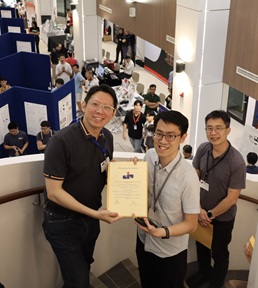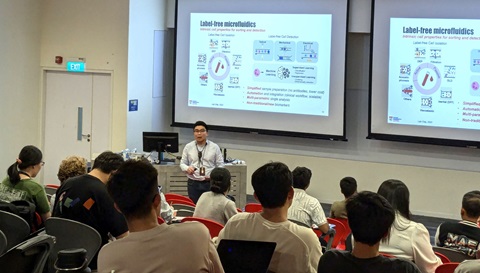Ion Channels for Sensing Temperature, Touch and Chili Peppers: 2021 Nobel Prize in Physiology or Medicine
Prof George Augustine, Irene Tan Liang Kheng Chaired Professor of Neuroscience | NTU Lee Kong Chian School of Medicine
Our nervous system encodes, computes and stores information by generating electrical signals. These signals are produced by ion channels, proteins found in cellular membranes. Channels possess a narrow pore that allows ions to diffuse from one side of the membrane to the other side, thereby generating electrical current. The 2021 Nobel Prize in Physiology or Medicine was awarded to Prof David Julius (University of California, San Francisco) and Prof Ardem Patapoutian (Howard Hughes Medical Institute, Scripps Research) for their studies of ion channels that are responsible for our ability to sense temperature and touch.

Image source: https://www.nobelprize.org/prizes/medicine/2021/summary/
Although we are sensitive to stimuli such as temperature and touch, how our nervous system transduces such stimuli into electrical signals was very poorly understood until Julius began his ground-breaking research. He set out to understand how our bodies
sense capsaicin, a chemical that gives us a hot sensation when we eat chili peppers. Julius and his colleagues identified a gene, called TRPV1, that encodes an ion channel that responds to capsaicin: inserting this channel gene into cells made the
cells became very sensitive capsaicin. Remarkably, addition of TRPV1 also made the cells very responsive to heat, specifically temperatures above 40oC. Thus, the same ion channel that allows us to sense hot chilis also allows us to sense
actual heat!
Structure of the TRPV1 channel discovered by Prof David Julius and colleagues:
From a top view, we can see that this channel has 4 subunits (colors), that together form a central pore. From a side view, we can see how TRPV1 spans a cell membrane (brown structure), allowing the pore to connect the solution outside the cell (blue) with the interior of the cell (beige). From Augustine et al. Neuroscience, Seventh Edition (Oxford Univ. Press), in press. |
Follow-up work done by Julius, Patapoutian, and others identified another channel sensitive to cool temperatures below 30oC. This channel is also sensitive to menthol, the compound that gives us a cool sensation when we eat mint; therefore this channel provides the sensation of coolness to both cold temperatures and to menthol. Still other ion channels sense temperatures near our body temperature, painfully hot temperatures (over 50oC) and freezing cold temperatures around 0oC. We now know that all these channels are members of a family that sense the entire physiological range of temperatures and additionally respond to a wide variety of chemical signals.
Patapoutian and his lab colleagues went on to do pioneering work to identify the ion channels involved in sensing touch. Using a clever genetic screening strategy, they identified two ion channel genes that confer mechanical sensitivity to cells. One of these, called Piezo2, seems to be involved in the sensation of touch in skin: genetic elimination of this gene in mice eliminated the ability to sense light touch of the skin. Human patients with defective Piezo2 channels also have impaired proprioception, the ability to sense the position of their limbs during movement. Piezo2 is thus a mechanosensitive channel that transduces mechanical force into cellular electrical signals.
Structure of the Piezo2 channel discovered by Prof Ardem Patapoutian and colleagues:
From a top view, we can see that this channel has 3 subunits (colors) that form a central pore. From a side view, we can see how Piezo2 spans a cell membrane (brown structure), allowing the pore to connect the solution outside the cell (blue) with the interior of the cell (beige). Mechanical force displaces the unique blades of Piezo2, causing its pore to open and permitting electrical current to flow. From Augustine et al. Neuroscience, Seventh Edition (Oxford Univ. Press), in press. |
In summary, the work of Julius and Patapoutian greatly enhances the understanding of how we sense our external and internal environments. This work was richly deserving of the 2021 Nobel Prize in Physiology or Medicine and is the latest - dating back
to the 1963 Prize awarded to Alan Hodgkin, Andrew Huxley and Jack Eccles – to acknowledge the profound importance of ion channels in both physiology and medicine.
For more information, watch the video here on 2021 Nobel Prize In Physiology or Medicine.









